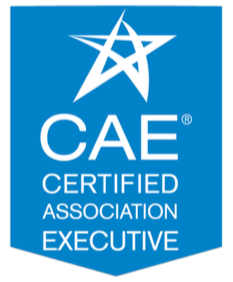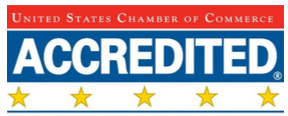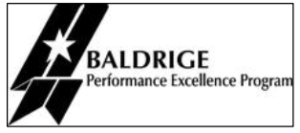Building Organizational Excellence is a class taught at the Institute for Organization Management (IOM) sponsored by the US Chamber of Commerce Foundation.
I start the class by asserting, “Organizational excellence starts with a commitment. To be the best you must have a hunger.”
Reaching excellence will distinguish the organization from mediocre ones. In inward evaluation is an important part of the process. Do not let identified weaknesses be a roadblock.
Excellence can improve leadership and staff pride. Stakeholders may gain renewed interest. Volunteers will appreciate the stature. Lawmakers, the media and public will garner new respect.
Starting Point
“Our organizational overhaul was kick-started during the strategic planning process. After identifying areas of deficiency and opportunity, we embarked on several years of purposeful and focused change,” said Desiree Bennyhoff, IOM, ACE, president and CEO at the. Edwardsville/Glen Carbon Chamber of Commerce.
For the chamber, we transformed by eliminating programs that were not aligned with its mission, restructuring the governance model, streamlining and downsizing its board of directors, innovating new programs to better serve members, concentrated involvement with business advocacy, and committing to apply for U.S. Chamber Accreditation.
“We live in a community that respects excellence. When we announced accreditation as a goal it was well received by members and the community. Unwavering board support and staff commitment have allowed us to achieve excellence. The strategic planning and accreditation processes led us along path of quality and innovation.”
Platforms for Excellence
It doesn’t matter so much how you reach excellence, so long as you commit, follow through, and achieve it.
Part of the improvement process includes identifying weaknesses, omissions and short comings. For example, in seeking a personal certification one might identify gaps in financial understanding. In applying for an organizational accreditation, it may be found that the organization relies on an outdated strategic.
There are several paths to realize excellence. Decide what is most appropriate and cost effective:
• Certification – awarded to individuals
• Accreditation – awarded to organizations
• Benchmarking – setting goals, measuring outcomes
• Awards of Excellence – in recognition of outstanding performance
Certification – To recognize personal achievement, seek certification. Common to associations and chambers of commerce are the CAE and CCE. The Certified Association Executive designation is administrated by the American Society of Association Executives (ASAE). The Certified Chamber Executive is a designation from the Association of Chamber of Commerce Executives (ACCE). 
Most certifications require a self-assessment (“Am I ready?”), followed by an application, acceptance as a certification candidate, a prescribed course of study, and an exam. Certified persons promote the designation on their business card, in email signatures, and in written communications by including the certification letters after their name. Renewal is required periodically to maintain the designation.
Accreditation – As certification is to the individual, accreditation is to the organization. For chambers of commerce, the U.S. Chamber offers a thorough accreditation process covering nine domains: governance, finance, human resources, government affairs, program development, technology, communications, facilities and benchmarking.
The best approach is to include the volunteer leaders and staff in the accreditation process, as this will deepen their understanding of the organization and increase their desire to strive for excellence.
The process of becoming accredited requires an organization to analyze its documents, systems and effectiveness. If important documents (e.g., policies, manuals, procedures) are missing, they should be created. Where systems are lacking, they will be improved.
 Accreditation requires the submission of documents and supporting examples to a review body. The accrediting board evaluates submission packages, then grants or denies accreditation. While a similar program does not exist for associations, the U.S. Chamber’s accreditation program serves as a robust road map for a voluntary assessment of health for all exempt organizations.
Accreditation requires the submission of documents and supporting examples to a review body. The accrediting board evaluates submission packages, then grants or denies accreditation. While a similar program does not exist for associations, the U.S. Chamber’s accreditation program serves as a robust road map for a voluntary assessment of health for all exempt organizations.
Benchmarking – Benchmarks are external standards against which to compare and measure. For example, the board may ask, “How much should we spend on technology?”
Respects benchmarks can be found in ASAE or ACCE reports on operating ratios. Other benchmarks may include membership statistics, staff compensation and budget to savings ratio.
Another reason to know the compensation benchmarks is the question on IRS Form 990, “Did the process for determining compensation of the following persons include a review and approval by independent persons, comparability data, and contemporaneous substantiation of the deliberation and decision?”
Performance Measures – Measuring performance transforms uninformed decisions to knowledge-based choices. Too often, group-think creeps into deliberations by a board of directors, “I voted for it because you proposed it.” It is better to frequently ask, “How will we measure performance” on proposals and programs. When metrics are agreed upon, progress can be measured. Knowledge makes adjusting or sunsetting underperforming programs more effective. Defining success is an important practice. When embarking on any program, service or initiative, always ask, “How will we know that the program is successful?”
Awards of Excellence – Peer groups usually offer recognitions, for instance, “best communication brochure” or “most improved organization.” Receipt of awards should boost board, staff and community confidence.
One of the most prestigious awards in the US is the Malcolm Baldrige Award. The organization oversees the nation’s only presidential award for performance excellence for business, government and nonprofit organizations. Most states have a counterpart to the national program, often identified as a state’s “Award of Performance Excellence.”
 The Baldrige Award and state counterparts focus on seven areas, nearly aligned with association and chamber operations. Those domains include leadership, strategy, customers/membership, performance measures, workforces, processes and outcomes. The support documents describing the award, and the process itself, are good resources for organizational assessment.
The Baldrige Award and state counterparts focus on seven areas, nearly aligned with association and chamber operations. Those domains include leadership, strategy, customers/membership, performance measures, workforces, processes and outcomes. The support documents describing the award, and the process itself, are good resources for organizational assessment.
Success!
“Applying for accreditation was a cornerstone of our strategic plan. Our chamber accomplished accreditation by committing to do the work, resisting the urge to deviate from our road map, and ultimately achieving excellence.”
“In March 2019, the chamber was awarded the accreditation. We received the five-star distinction, the highest level. The board and staff are incredibly proud of our success and adherence to industry best practices. We are using the accrediting board’s recommendations to strive for continuous improvement.”
We encourage associations and chambers, regardless of size, budget or mission, to strive for excellence.
###
Note: Bob Harris, CAE, provides free governance tips and templates at www.nonprofitcenter.com. Desiree Bennyhoff, IOM, ACE is President and CEO at the Edwardsville/Glen Carbon Chamber of Commerce
Leave a Reply